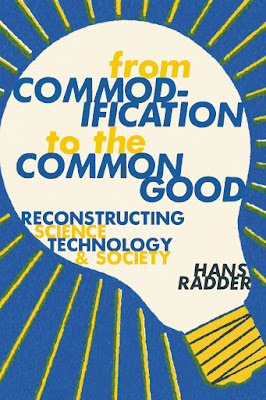Volume 3, Issue 3: From Common Good to a Theory and Practice of Common Good
From Common Good to a Theory and Practice of Common Good: Hans Radder on Technology, Science, and Society
Hans Radder: From Commodification to the Common Good: Reconstructing Science, Technology, and Society. Pittsburgh: University of Pittsburgh Press, 2019, pp. x +299. Hardcover ISBN: 978-0-8229-4579-6, $45.00.R
Technology, science, and society are terms that are notoriously interwoven on many levels, and famously hard to disentangle satisfactorily. In his latest book, From Commodification to the Common Good: Reconstructing Science, Technology, and Science, Hans Radder did not try to make a sharp distinction between these fields to approach them separately. Rather, he made a novel book about how to consider science and technology within their social outfit in a systematic and organic form.
What drives Radder is a general concern about the historical development of science within our new socio-political environment, namely bureaucratization, administration, and commodification (p. 262). While all of them deserve a book-length treatment, Radder concentrates exclusively on the third one. “Commodification” is a term that comes mainly from the Marxist literature and concerns the way something earns new types of commercial, market-related exchange-values (mainly in money), replacing or heavily supplementing the original use value (pp. 92 ff.). Thus science and scientific knowledge, usually aiming at either the truth or some form of social utility, became highly commodified during the (second half of the) twentieth century, leaving often behind its intrinsic cognitive and external social values in favor of more economic-related values.
The issue becomes especially interesting for Radder with the case of patents. A patent, in a simplistic form, is “a legally granted right to exploit a particular technological invention. More precisely, it is the right of the patent holder(s) to exclude all other people or institutions from reaping any economic benefits from this invention” (p. 137). By way of patenting and money-related economical visibility gained through commerce, science became measurable by seemingly more “objective” (that is, quantifiable) terms, with the possibility of a hint of social usage (through the market). Leaving behind the question of how useful and socially expedient most scientific patents really are (and how the earning made through their patents are distributed among collaborators and scientists, not discussed in detail by Radder), the increase of patenting at research and teaching institutes put another burden on the shoulder of social and human scientists. As patenting is not a typical issue (partly due to legal issues, partly due to their internal interests) of the social and human sciences, it can easily be guessed by anyone that they start in the big scientific competition for the goodwill of society, politicians, and policy-makers from a significantly handicapped position. One of the biggest strengths and merits of Radder’s book is his general sensitivity towards and argumentation for the social and human sciences (a rare concern of philosophers of science, even nowadays).
The first three chapters of the book are somewhat explorative and critical with the available definitions and concerns of scientists and philosophers. Radder takes a look at the science-technology division (Chapter 1), the nature and normativity of technologies within a society (Chapter 2), and the theory and practice of scientific patenting (Chapter 3). A lot is going on in these sections, and it is often quite hard for the reader to follow all the back-and-forth between Radder and the numerous positions he reconstructs and criticizes. What is even worse is that sometimes the reader is unsure after one initial reading of what the take-home message is. Radder talks about “open-ended research program[s]” (p. 117), thus leaving some backdoors open for further discussions, but notes also that philosophers of science and technology do not always agree on the relevant philosophical approaches and claims. Because of the fundamental nature of the issues at stake and the diversity of views, universal agreement on all issues among all philosophers will not be forthcoming” (pp. 117-118). Though Radder is concerned here with the nature and definition of patenting, his diagnosis could be extended to the whole project.
And this is an important point, I would say. Though science and technology are invading our social life through and through, it seems to be impossible to reach any general and sufficiently comprehensive consensus about the nature, aim, and role of science and technology. While one might add that “from a philosophical point of view”, thus weakening the skeptical views by pointing out that beyond philosophy, consensus is a rare, but achievable stance, this is not entirely true. All economical and socio-political stances are backed up by a general, philosophically relevant, and scrutinizable worldview. Thus a general descriptivist project of reconstructing the rationale of general discussions is seemingly doomed to failure because of the available ration pluralities of philosophical positions and (counter)argumentations.
But Radder has a pretty old but good solution to this (though this solution makes the book a pretty hard reading). Radder is pursuing a systematic/synthetic and normative philosophy. Chapters 5-8 are devoted to Radder’s own recommendations, suggestions, and philosophical outlook on how science and technology could be transformed from a market-oriented and money-oriented legal enterprise into a socially driven rational undertaking for the common good. He discusses the nature of scientific knowledge (Chapter 5), the nature and criteria of public good/interest (Chapter 6), the relation between the two (Chapter 7), and provides a succinct summary and bird’s eye perspective on his own venture (Chapter 8).
Radder is making deep conceptual and systematic connections between his fields of inquiry and pursues his project always with an eye towards the big-picture (that is why he often has to make caveats about the (lack of specialized) depth and illuminative generalness of his claims and arguments, see, e.g. pp. 257-258). But the measure of his synthesis shall not be a description of current or past science (within a society), but the socio-political attractiveness of his new vision. While I would share many of his findings and recommendations, that is the weakest point of the book, unfortunately. Given the language and stratified character of Radder’s book, his story is written for philosophers and policy-makers (e.g. mainly for an academic circle), though the implications and outreach are aimed at a wider audience who shall most presumably never took this book in their hands.
But for philosophers, there is much to discuss, if nothing more than Chapter 4, where Radder reconstructs Robert Merton’s famous norms of scientific conduct and research (communism, universalism, disinterestedness, and organized skepticism). He finds them lacking (as most contemporary readers do) because of their abstractness and generality, but Radder is also able to transform them (in letter but not in spirit) into a somewhat updated “neo-Mertonian ethos”.
There is much more in the book that would deserve a careful study and conceptualization here. But for the time being, it suffices to say that Radder’s book is an important step towards the rehabilitation of the old normative philosophy of science that not just tries to criticize the matter in hand, but also tries to provide useful guides on how to move on for a better future. Hopefully, a user-friendlier version is also forthcoming for the wider audiences. It deserves it.
Adam Tamas Tuboly
Institute of Philosophy, Research Centre for the Humanities, ELRN
Supported by the MTA Lendulet Morals and Science Research group and by the MTA Premium Postdoctoral Scholarship.




Comments
Post a Comment